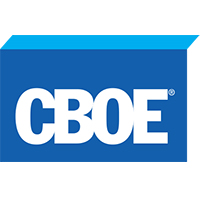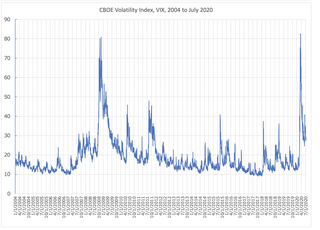Related Research Articles
The Black–Scholes or Black–Scholes–Merton model is a mathematical model for the dynamics of a financial market containing derivative investment instruments, using various underlying assumptions. From the parabolic partial differential equation in the model, known as the Black–Scholes equation, one can deduce the Black–Scholes formula, which gives a theoretical estimate of the price of European-style options and shows that the option has a unique price given the risk of the security and its expected return. The equation and model are named after economists Fischer Black and Myron Scholes; Robert C. Merton, who first wrote an academic paper on the subject, is sometimes also credited.
In financial mathematics, the implied volatility (IV) of an option contract is that value of the volatility of the underlying instrument which, when input in an option pricing model, will return a theoretical value equal to the current market price of said option. A non-option financial instrument that has embedded optionality, such as an interest rate cap, can also have an implied volatility. Implied volatility, a forward-looking and subjective measure, differs from historical volatility because the latter is calculated from known past returns of a security. To understand where implied volatility stands in terms of the underlying, implied volatility rank is used to understand its implied volatility from a one-year high and low IV.
Market risk is the risk of losses in positions arising from movements in market variables like prices and volatility. There is no unique classification as each classification may refer to different aspects of market risk. Nevertheless, the most commonly used types of market risk are:

The Chicago Board Options Exchange (CBOE), located at 433 West Van Buren Street in Chicago, is the largest U.S. options exchange with an annual trading volume of around 1.27 billion at the end of 2014. CBOE offers options on over 2,200 companies, 22 stock indices, and 140 exchange-traded funds (ETFs).

Volatility smiles are implied volatility patterns that arise in pricing financial options. It is a parameter that is needed to be modified for the Black–Scholes formula to fit market prices. In particular for a given expiration, options whose strike price differs substantially from the underlying asset's price command higher prices than what is suggested by standard option pricing models. These options are said to be either deep in-the-money or out-of-the-money.
The S&P 100 Index is a stock market index of United States stocks maintained by Standard & Poor's.
In finance, volatility arbitrage is a term for financial arbitrage techniques directly dependent and based on volatility.

VIX is the ticker symbol and the popular name for the Chicago Board Options Exchange's CBOE Volatility Index, a popular measure of the stock market's expectation of volatility based on S&P 500 index options. It is calculated and disseminated on a real-time basis by the CBOE, and is often referred to as the fear index or fear gauge.
The CBOE S&P 500 BuyWrite Index is a benchmark index designed to show the hypothetical performance of a portfolio that engages in a buy-write strategy using S&P 500 index call options.
The following outline is provided as an overview of and topical guide to finance:

In finance, an option is a contract which conveys to its owner, the holder, the right, but not the obligation, to buy or sell a specific quantity of an underlying asset or instrument at a specified strike price on or before a specified date, depending on the style of the option. Options are typically acquired by purchase, as a form of compensation, or as part of a complex financial transaction. Thus, they are also a form of asset and have a valuation that may depend on a complex relationship between underlying asset price, time until expiration, market volatility, the risk-free rate of interest, and the strike price of the option. Options may be traded between private parties in over-the-counter (OTC) transactions, or they may be exchange-traded in live, public markets in the form of standardized contracts.
The CBOE S&P DJIA BuyWrite Index is a benchmark index designed to show the hypothetical performance of a portfolio that engages in a buy-write strategy on the Dow Jones Industrial Average (DJIA).
Simply stated, Post-Modern Portfolio Theory (PMPT) is an extension of the traditional Modern Portfolio Theory (MPT) of Markowitz and Sharpe. Both theories provide analytical methods for rational investors to use diversification to optimize their investment portfolios. The essential difference between PMPT and MPT is that PMPT emphasizes the return that must be earned on an investment in order to meet future, specified obligations, MPT is concened only with the absolute return vis-a-vis the risk-free rate.

In finance, volatility is the degree of variation of a trading price series over time, usually measured by the standard deviation of logarithmic returns.
The CBOE S&P 500 PutWrite Index is a benchmark index that measures the performance of a hypothetical portfolio that sells S&P 500 Index (SPX) put options against collateralized cash reserves held in a money market account.
The bias ratio is an indicator used in finance to analyze the returns of investment portfolios, and in performing due diligence.

IVX is a volatility index providing an intraday, VIX-like measure for any of US securities and exchange traded instruments. IVX is the abbreviation of Implied Volatility Index and is a popular measure of the implied volatility of each individual stock. IVX represents the cost level of the options for a particular security and comparing to its historical levels one can see whether IVX is high or low and thus whether options are more expensive or cheaper. IVX values can be compared for the stocks within one industry to find names which significantly differ from what is observed in overall sector.
Tail risk, sometimes called "fat tail risk," is the financial risk of an asset or portfolio of assets moving more than three standard deviations from its current price, above the risk of a normal distribution. Tail risks include low-probability events arising at both ends of a normal distribution curve, also known as tail events. However, as investors are generally more concerned with unexpected losses rather than gains, a debate about tail risk is focused on the left tail. Prudent asset managers are typically cautious with the tail involving losses which could damage or ruin portfolios, and not the beneficial tail of outsized gains.
The S&P/ASX200 VIX (A-VIX) is a financial market product that participants trade based on the market price of the implied volatility in the underlying Australian equity index.

In economics and finance, a holy grail distribution is a probability distribution with positive mean and right fat tail — a returns profile of a hypothetical investment vehicle that produces small returns centered on zero and occasionally exhibits outsized positive returns.
References
- ↑ Chicago Board Options Exchange. "Introduction to CBOE SKEW Index" . Retrieved 21 March 2017.
- ↑ John Abbink. "Is The SKEW Index Predictive For The S&P 500?".
SKEW ... indicates the degree to which the median return is expected to differ from the mean, and the extent to which the distribution will include more and/or more extreme outliers.
- ↑ Frederic Ruffy (18 February 2016). "Volatility Update: Options Skew Requires Look Below the Surface" . Retrieved 25 March 2017.